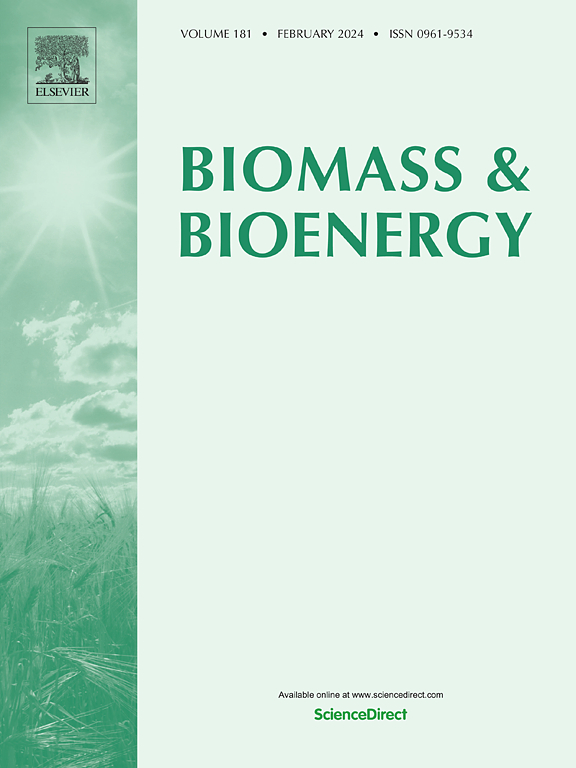利用生物质-微波相互作用研究芥菜(Brassica Nigra)外壳(MSH)的介电特性及其储能应用
IF 5.8
2区 生物学
Q1 AGRICULTURAL ENGINEERING
引用次数: 0
摘要
大量农业废弃物的产生及其处置不当可能导致各种环境、污染和健康问题。需要开发一种处理或利用废物的有效技术。近几十年来,生物质能已成为一种流行的能源储存方式。微波热解是一种从固体废物中制备高碳质多孔炭的重要技术。这种炭可用于不同的应用,包括开发生物质衍生的超级电容器电极。微波热解过程中生物质与微波的相互作用至关重要,它决定了微波热解过程的效率和效果。在30-600℃的温度范围内,研究了芥菜壳(MSH)在900 MHz和2450 MHz两个不同频率下的介电特性。在30℃时,MSH的介电常数ε′在900 MHz和2450 MHz分别为3.275和2.978,介电损耗ε′在900 MHz和2450 MHz分别为0.268和0.311。在研究温度范围(30 ~ 600℃)内,900 MHz频率下ε′和ε′值分别下降42.41%和65.67%,2450 MHz频率下ε′和ε′值分别下降40.16%和61.73%。在900 MHz和2450 MHz频率下,当温度从30℃增加到600℃时,穿透深度分别增加102.01%和120.937%。介电常数值被拟合到已有的玻尔兹曼和高斯模型中。研究表明,MSH与微波有高度的相互作用,微波热解适于从农业废弃物中生产富能产品。本研究采用了一种新的方法将MSH转化为增值产品。其新颖之处在于,MSH不能用于其他替代品,如动物饲料、作物施肥等。而在露天环境中大量燃烧MSH对环境造成了危害。因此,MSH在很大程度上可能有助于储能应用,最终有利于环境和可再生资源的利用。本文章由计算机程序翻译,如有差异,请以英文原文为准。
Dielectric characterization of mustard (Brassica Nigra) husk (MSH) by investigating biomass-microwave interaction for energy storage applications
Generation of huge amount of agricultural waste and its inappropriate disposal may lead to various environmental, pollution and health related issues. Development of an efficient technique for the disposal or utilization of waste is needed. Biomass, in recent few decades, has become popular for the energy storage. Microwave pyrolysis is a prominent technique to produce highly carbonaceous porous char form solid waste. This char may be used in different applications including development of biomass-derived supercapacitor electrodes. Biomass-microwave interaction during microwave pyrolysis is crucial and it determines the efficacy and effectiveness of the microwave pyrolysis process. In the present study, dielectric properties of mustard husk (MSH) at two different frequencies (900 MHz and 2450 MHz) have been investigated within the temperature range of 30–600 °C. At 30 °C, the dielectric constant (ε′) of MSH is 3.275 at 900 MHz and 2.978 at 2450 MHz while the dielectric loss (ε′′) is 0.268 at 900 MHz and 0.311 at 2450 MHz. Within the studied temperature range (30–600 °C), ε′ and ε′′ values decreased by 42.41 % and 65.67 % at 900 MHz frequency while these lowered by 40.16 % and 61.73 % at 2450 MHz frequency. Penetration depth shows 102.01 % and 120.937 % rise on increasing the temperature from 30 to 600 °C for 900 MHz and 2450 MHz frequencies, respectively. Dielectric constant values were fitted to pre-existing Boltzmann and Gauss models. The study suggests that MSH interacts to microwave to a high extent and microwave pyrolysis is suitable to produce the energy rich product from agricultural wastes. The present study utilises novel approach of converting MSH into value added product. The novelty lies in the fact that MSH cannot be used in other alternative like animal feeding of crop fertilization etc. And burning huge amount of MSH in open environment creates hazardous environmental impact. Thus, MSH available largely may be contributes to energy storage application that eventually benefits the environment and use of renewable resources.
求助全文
通过发布文献求助,成功后即可免费获取论文全文。
去求助
来源期刊

Biomass & Bioenergy
工程技术-能源与燃料
CiteScore
11.50
自引率
3.30%
发文量
258
审稿时长
60 days
期刊介绍:
Biomass & Bioenergy is an international journal publishing original research papers and short communications, review articles and case studies on biological resources, chemical and biological processes, and biomass products for new renewable sources of energy and materials.
The scope of the journal extends to the environmental, management and economic aspects of biomass and bioenergy.
Key areas covered by the journal:
• Biomass: sources, energy crop production processes, genetic improvements, composition. Please note that research on these biomass subjects must be linked directly to bioenergy generation.
• Biological Residues: residues/rests from agricultural production, forestry and plantations (palm, sugar etc), processing industries, and municipal sources (MSW). Papers on the use of biomass residues through innovative processes/technological novelty and/or consideration of feedstock/system sustainability (or unsustainability) are welcomed. However waste treatment processes and pollution control or mitigation which are only tangentially related to bioenergy are not in the scope of the journal, as they are more suited to publications in the environmental arena. Papers that describe conventional waste streams (ie well described in existing literature) that do not empirically address ''new'' added value from the process are not suitable for submission to the journal.
• Bioenergy Processes: fermentations, thermochemical conversions, liquid and gaseous fuels, and petrochemical substitutes
• Bioenergy Utilization: direct combustion, gasification, electricity production, chemical processes, and by-product remediation
• Biomass and the Environment: carbon cycle, the net energy efficiency of bioenergy systems, assessment of sustainability, and biodiversity issues.
 求助内容:
求助内容: 应助结果提醒方式:
应助结果提醒方式:


